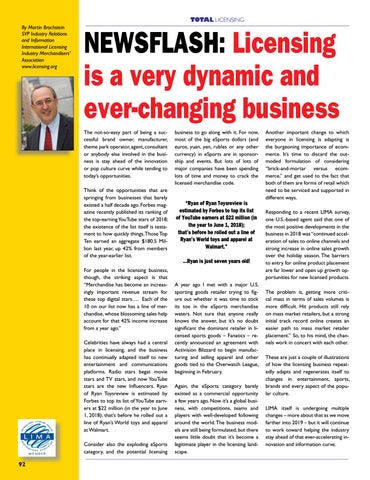TOTAL LICENSING By Martin Brochstein SVP Industry Relations and Information International Licensing Industry Merchandisers’ Association www.licensing.org
NEWSFLASH: Licensing is a very dynamic and ever-changing business The not-so-easy part of being a successful brand owner, manufacturer, theme park operator, agent, consultant or anybody else involved in the business is stay ahead of the innovation or pop culture curve while tending to today’s opportunities. Think of the opportunities that are springing from businesses that barely existed a half decade ago. Forbes magazine recently published its ranking of the top-earning YouTube stars of 2018; the existence of the list itself is testament to how quickly things. Those Top Ten earned an aggregate $180.5 Million last year, up 42% from members of the year-earlier list. For people in the licensing business, though, the striking aspect is that “Merchandise has become an increasingly important revenue stream for these top digital stars…. Each of the 10 on our list now has a line of merchandise, whose blossoming sales help account for that 42% income increase from a year ago.” Celebrities have always had a central place in licensing, and the business has continually adapted itself to new entertainment and communications platforms. Radio stars begat movie stars and TV stars, and now YouTube stars are the new Influencers. Ryan of Ryan Toysreview is estimated by Forbes to top its list of YouTube earners at $22 million (in the year to June 1, 2018); that’s before he rolled out a line of Ryan’s World toys and apparel at Walmart. Consider also the exploding eSports category, and the potential licensing
92
business to go along with it. For now, most of the big eSports dollars (and euros, yuan, yen, rubles or any other currency) in eSports are in sponsorship and events. But lots of lots of major companies have been spending lots of time and money to crack the licensed merchandise code.
“Ryan of Ryan Toysreview is estimated by Forbes to top its list of YouTube earners at $22 million (in the year to June 1, 2018); that’s before he rolled out a line of Ryan’s World toys and apparel at Walmart.” ...Ryan is just seven years old!
A year ago I met with a major U.S. sporting goods retailer trying to figure out whether it was time to stick its toe in the eSports merchandise waters. Not sure that anyone really knows the answer, but it’s no doubt significant the dominant retailer in licensed sports goods – Fanatics – recently announced an agreement with Activision Blizzard to begin manufacturing and selling apparel and other goods tied to the Overwatch League, beginning in February. Again, the eSports category barely existed as a commercial opportunity a few years ago. Now it’s a global business, with competitions, teams and players with well-developed following around the world. The business models are still being formulated, but there seems little doubt that it’s become a legitimate player in the licensing landscape.
Another important change to which everyone in licensing is adapting is the burgeoning importance of ecommerce. It’s time to discard the outmoded formulation of considering “brick-and-mortar versus ecommerce,” and get used to the fact that both of them are forms of retail which need to be serviced and supported in different ways. Responding to a recent LIMA survey, one U.S.-based agent said that one of the most positive developments in the business in 2018 was “continued acceleration of sales to online channels and strong increase in online sales growth over the holiday season. The barriers to entry for online product placement are far lower and open up growth opportunities for new licensed products. The problem is, getting more critical mass in terms of sales volumes is more difficult. Hit products still rely on mass market retailers, but a strong initial track record online creates an easier path to mass market retailer placement.” So, to his mind, the channels work in concert with each other. These are just a couple of illustrations of how the licensing business repeatedly adapts and regenerates itself to changes in entertainment, sports, brands and every aspect of the popular culture. LIMA itself is undergoing multiple changes – more about that as we move farther into 2019 – but it will continue to work toward helping the industry stay ahead of that ever-accelerating innovation and information curve.
